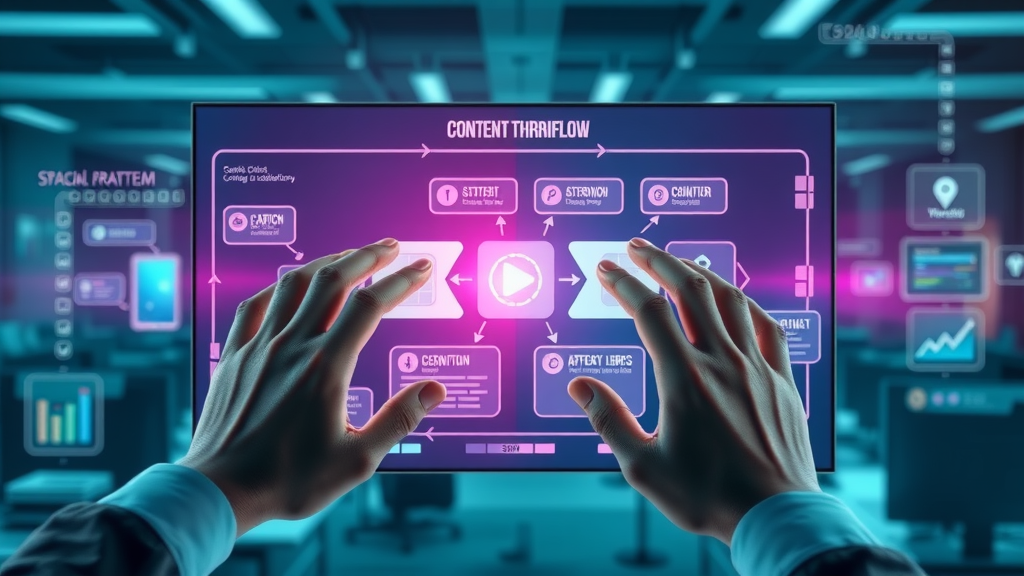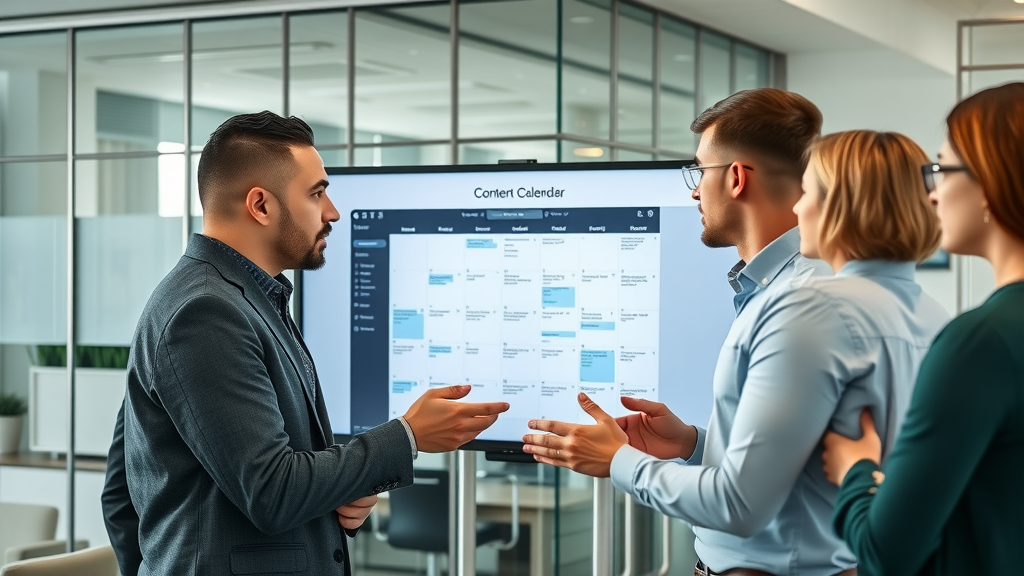Did you know that over 60% of marketers believe choosing the right content distribution channels is the number one driver of visibility and ROI in digital marketing? That’s because delivering stellar content is only half the battle—knowing where and how to distribute content is what separates unforgettable brands from the rest. In this guide, discover practical strategies, expert insights, and actionable steps to power up your content marketing success and reach audiences you never thought possible. Read on and prepare to transform your content’s impact in a crowded digital ecosystem!
Unlock Massive Audiences Through Strategic Content Distribution Channels
At the heart of every successful content marketing campaign is a smart, adaptable content distribution strategy. By leveraging diverse content distribution channels like social media platforms, email newsletters, third-party sites, and paid content distribution, you unlock pathways to audiences who would otherwise miss your message completely. Not only does this stretch the reach of every blog post or press release, but it also maximizes brand awareness and can lead to exponential growth in audience engagement.
For example, pairing a valuable blog post with an engaging social media post, a relevant email newsletter, and a paid ad campaign ensures your content isn’t just found—it’s actively consumed. Imagine sharing a well-researched case study, then distributing it via LinkedIn, a targeted press release, and through influencer partnerships on niche media channels. Suddenly, you’re reaching segmented groups of your target audience, all of whom are primed to take action. This level of strategic distribution is what propels a piece of content from overlooked to unforgettable.

Over 60% of marketers claim that identifying the right content distribution channels is the top driver of visibility and ROI in digital marketing.
- How to choose and prioritize content distribution channels for different content types.
- Actionable content distribution strategies to maximize your reach.
- Key metrics to measure content marketing effectiveness.
- Practical steps to implement a winning distribution strategy.
Understanding Content Distribution Channels: An In-Depth Primer
What Are Content Distribution Channels?
Content distribution channels are the paths through which your content journeys to meet its audience. Whether you’re sharing blog posts on your company website (owned channel), sending out press releases that get picked up by media channels (earned channel), or investing in paid ads to amplify your messaging (paid channel), each distribution channel serves as a vital touchpoint with your target audience. Understanding these pathways is crucial because it determines how well your content marketing efforts achieve reach, engagement, and tangible results.
Content distribution channels are the platforms or methods by which your content reaches your target audience, including social media, email, blogs, and more.
- Owned channels (blog posts, company website, email newsletters)
- Earned channels (press releases, guest posts, influencer mentions)
- Paid channels (paid content distribution, paid ads, sponsored posts)

The Role of Content Distribution in Content Marketing
In a world where content creation is easier than ever, cutting through the noise is critical. A robust content distribution strategy ensures your expertly crafted blog post, compelling press release, or dynamic video gets delivered to the people who need it most. The relationship between content marketing and content distribution is symbiotic—content distribution amplifies the reach of your efforts, converts passive audiences into active consumers, and supercharges brand awareness. The most effective campaigns are those that balance high-quality content creation with targeted, well-timed distribution across a range of channels suited to the message and format.
This holistic approach allows marketers to maximize every piece of content’s potential. By carefully selecting where your audience spends their time and optimizing content delivery on those platforms, you’re not just distributing—you’re engaging, educating, and inspiring meaningful interactions.
Key Metrics and Goals for Content Distribution Channel Selection
Every content distribution channel serves a unique purpose and delivers different metrics. To choose the right distribution channels, you need to establish clear goals—are you aiming to boost traffic, drive conversions, or build long-term loyalty? Key metrics include reach, engagement rates, click-through rates, shares, and ultimately, conversion rate and ROI. Tools like Google Analytics, built-in social media analytics, and email platform insights enable marketers to assess which channels perform best for each piece of content and adjust their strategies accordingly.
For instance, a high click-through rate from an email newsletter signals an engaged list, whereas a spike in referral traffic from a press release could demonstrate successful earned media outreach. Balancing these key performance indicators ensures you invest in content distribution strategies that yield real, measurable results tailored to your business objectives.
Designing Your Optimal Content Distribution Strategy
Analyzing Your Target Audience and Their Preferred Distribution Channels
Start by understanding where your target audience spends time and how they prefer to consume content. Are they professionals seeking in-depth blog posts on LinkedIn, visual learners scrolling Instagram, or executives reading industry press releases? Audience demographics, behaviors, and content consumption habits are fundamental data points—using analytics tools, customer surveys, and competitor research can reveal which media channels to prioritize in your distribution strategy.
Furthermore, segmenting your audience by interests, buyer journey stage, or geographic region ensures your message reaches the right people at the right time. This data-driven approach enables you to personalize delivery, boost engagement rates, and increase conversions, making every piece of content you distribute on each media channel work harder for your business.

Aligning Content Types to the Best Media Channels
Some types of content naturally perform better on certain platforms. For example, video clips or infographics thrive on visually-driven social media platforms like Instagram or TikTok, while whitepapers, guides, and in-depth blog posts may see more traction through targeted LinkedIn posts or email newsletters. Press releases are ideally suited for earned media channels and industry publications. The best distribution strategy matches each type of content with the most effective media platform to maximize exposure and audience response.
- Map content formats to the most effective media platforms
- Know when to use social media platforms vs. media channels
- Segment distribution channels for different target audiences
| Content Type | Email Newsletter | Press Release | Paid Content | Social Media Channel | Media Platform |
|---|---|---|---|---|---|
| Blog Post | ✔ | — | ✔ | ✔ | ✔ |
| Whitepaper | ✔ | — | ✔ | — | ✔ |
| Press Release | — | ✔ | ✔ | ✔ | ✔ |
| Video/Social Clip | — | — | ✔ | ✔ | ✔ |
Top Content Distribution Channels to Maximize Your Reach
Social Media Platforms: Dominating Attention and Engagement
Few distribution channels rival the unrivaled reach and engagement potential of social media platforms . Whether it’s Facebook’s broad appeal, LinkedIn’s professional focus, or TikTok’s viral energy, each platform offers unique advantages for content distribution. Mastery in social media marketing means understanding your target audience’s preferred networks and tailoring your content for each channel’s strengths. For instance, quick how-to videos or fun challenges flourish on TikTok, while longer-form blog post summaries and industry insights are ideal for LinkedIn’s professional user base.
Social media also enables real-time interaction via comments, shares, and direct messages, helping brands build deeper relationships and foster community engagement. By using analytics and paid content distribution features native to these platforms, marketers can further boost visibility and track what resonates best with their audience.
- Twitter/X
- TikTok
- Niche platforms relevant to your audience

Email Newsletters: Building Loyal Audiences and Traffic
Email newsletters remain one of the most effective owned channels for content distribution. Unlike social media platforms, email provides a direct, personal conversation with your target audience, making it ideal for distributing new blog posts, special media posts, product updates, and exclusive offers. High open rates, personalized segments, and measurable click-throughs make email newsletters invaluable in driving consistent website traffic and nurturing loyal fans.
Personalizing email content so each piece of content aligns with reader interests or behavior—such as sending a leadership-focused blog post to managers—can drastically boost engagement rates. Moreover, emails are easily integrated with blog posts, social media posts, and even paid content distribution for a seamless, multi-channel content marketing experience.

Third-Party Media Channels: Leveraging Influencers, Press Releases, and Partnerships
Pushing your message beyond owned media channels is vital for brand growth. Third-party media channels—including press releases, influencer partnerships, and guest blog posts—grant unparalleled credibility and expanded exposure. For instance, publishing a press release through an industry media platform enables you to tap into established readerships, while influencer media posts can amplify your blog post or product announcement to thousands of new followers.
Collaborating with trusted partners or securing guest posts on high-authority blogs further enhances discoverability, signal value to search engines, and sets your content marketing apart from competitors reliant solely on owned and paid distribution channels.

Paid Content Distribution and Paid Ads: Extending Your Content Reach
Even the best blog post needs a boost to achieve maximum visibility. Paid content distribution—including sponsored social posts, native ads on media platforms, and display retargeting campaigns—ensures your message reaches both broad and highly targeted segments of your intended audience. Paid ads offer advanced targeting by demographics, interests, or remarketing lists, transforming a single blog post or press release into a lead generation powerhouse.
| Channel | Reach | Engagement Rate | Traffic | Conversion Rate |
|---|---|---|---|---|
| Social Media Platforms | High | High | Medium | Medium |
| Email Newsletters | Medium | Medium | High | High |
| Press Releases/3rd Party Media | Medium | Low | High | Medium |
| Paid Content & Paid Ads | High | Medium | High | High |
Content Distribution Strategy in Action: Step-by-Step Approach
- Define content marketing goals
- Audit existing distribution channels
- Develop a distribution strategy for each piece of content
- Schedule and automate content delivery
- Use analytics to refine distribution strategies

Optimizing a Blog Post for Multiple Content Distribution Channels
Let’s say you’ve published an insightful blog post about new trends in your industry. To maximize its reach, tailor the message for each distribution channel: share an engaging excerpt and graphic on LinkedIn, create a short animated video for Instagram, draft a detailed email newsletter highlighting key points, and collaborate with industry influencers to mention it in their next media post. Each version should suit the channel’s format and what your target audience expects. Cross-promoting your blog post using a content distribution strategy increases touchpoints and improves content marketing performance.
Integrating paid content distribution, such as boosting your LinkedIn post or running a paid ad on Facebook, can further expand reach, allowing your core message to gain traction with audiences outside your existing network.
Repurposing Content Across Distribution Channels for Maximum Value
Repurposing enables you to extend one piece of content’s lifespan and reach. Consider turning a comprehensive blog post into a series of social media posts, a downloadable checklist, a short educational video, and a guest blog post for an industry media platform. Each repurposed format should fit the optimal distribution channel, targeting unique segments within your audience and driving more consistent engagement with less content creation effort.
Tracking performance across each channel reveals which formats and platforms resonate best, allowing for continuous improvement and smarter resource allocation in future content creation campaigns.
People Also Ask: Essentials on Content Distribution Channels
What is a content distribution channel?
A content distribution channel is any platform, network, or pathway you use to share and promote your content to your target audience. Examples include your company blog, social media platforms, email newsletters, press releases distributed to industry publications, and paid ads. Each channel helps maximize your content’s reach, engagement, and impact in different ways.
What are the 4 distribution channels?
The four main types of distribution channels are: owned channels (like your website, blog posts, or email newsletters), earned channels (like guest posts, influencer media posts, and press releases picked up by third parties), paid channels (such as paid ads or promoted content on media platforms), and hybrid channels (which blend aspects of the three previous channels, like partnering with influencers on a sponsored social media post).
What is an example of a content distribution strategy?
An example of a content distribution strategy is creating a blog post and distributing it through multiple channels: share a teaser on Twitter, post the full article on your blog, email it to subscribers as part of your email newsletter, amplify it with a paid ad, and pitch a summary as a guest blog post on an industry media platform. This multi-channel approach ensures your content reaches diverse audiences in the formats they prefer.
What is a content distribution platform?
A content distribution platform is a tool or service designed to help you share, amplify, and manage your content across various distribution channels. Examples include social media scheduling tools, email marketing software, paid ad networks, press release distribution services, and influencer marketing platforms. They streamline the distribution process and make tracking results easier.
Evaluating the Impact of Content Distribution Channels
Tracking Performance and ROI across Media Platforms
Consistent measurement is vital to maximizing returns from your distribution strategy. Marketers rely on analytics dashboards to track traffic, engagement, conversions, and cost per acquisition for each media platform. Comparing these metrics across multiple distribution channels highlights high performers—such as a blog post that drives conversions from both email newsletters and LinkedIn—and identifies areas needing adjustment. Closing the feedback loop translates insights into smarter investment and more effective future content creation decisions.

Iterating and Improving Your Content Distribution Channel Mix
The digital landscape evolves rapidly. Frequent channel audits and strategic realignment keep your content marketing results strong. Experimenting with new platforms, repurposing successful blog posts for emerging social media channels, or reallocating budget from underperforming paid ads to high-converting media platforms can make a significant difference. Always let performance data—not habit—guide your content distribution mix to maintain agility and maximize ROI.
| Metric | Description |
|---|---|
| Traffic | Number of visitors from each distribution channel |
| Engagement Rate | Shares, likes, comments, and time spent on content |
| Conversion Rate | Percentage of visitors who take a desired action |
| Cost per Acquisition | Total cost divided by new customers or leads generated |
Expert Insights: Real-World Content Distribution Success Stories
“Choosing the right content distribution channel was the turning point in our lead generation efforts.” – Leading Content Marketer

- How press releases increased brand mentions
- Leveraging paid ads to boost blog post visibility
- Building a distribution strategy around audience preferences
These real-world case studies show that pairing the right distribution channels with tailored content creation accelerates results. For example, one company dramatically increased its brand awareness with a strategic press release campaign distributed through niche industry platforms, while another saw a spike in blog post traffic and conversions after experimenting with targeted paid ad campaigns. Success lies in understanding your audience, picking the right media channels, and optimizing over time.
Pitfalls to Avoid When Selecting and Using Content Distribution Channels
- Neglecting analytics
- Over-reliance on a single channel
- Poor alignment between content format and distribution channel
Maintaining Consistency Across All Distribution Channels
Consistency is essential for building brand trust and reinforcing your message. All distribution channels—from social media posts to email newsletters and paid content—should align in voice, design, and value proposition. Even minor discrepancies in tone or branding can confuse your audience and dilute your impact. Implement content distribution checklists and brand guidelines to create a seamless, professional experience across every platform.
Ensuring a Seamless User Experience
From the first social media post to a targeted paid ad, the user journey must be intuitive and frictionless. Optimize landing pages, check navigation paths, and ensure responsiveness across devices, so every distribution channel delivers a positive user experience. This attention to detail not only increases engagement rates but also builds long-term loyalty among your target audience.
FAQ: Mastering Content Distribution Channel Selection
- What are the most cost-effective content distribution channels? Owned channels like blogs and email newsletters are generally the most cost-effective, as you control them directly and avoid ongoing fees. Utilizing earned media through PR and guest posting can also deliver high value with minimal cost if you invest upfront in quality content creation.
- How often should you reassess your distribution strategy? Regular reviews—quarterly or after significant campaign launches—ensure you adapt to evolving audience preferences and identify new opportunities from emerging media platforms or distribution channel trends.
- Can small businesses compete on the same distribution channels as large brands? Yes! Small businesses can leverage niche-owned and earned distribution channels, focus on highly engaged segments, and use paid ads strategically to compete with larger brands without needing massive budgets.
- What tools help automate content distribution? Tools like Buffer, Hootsuite, HubSpot, or Mailchimp help streamline publishing across social media platforms, schedule blog posts, manage email newsletters, and monitor analytics to refine your strategy efficiently.
Actionable Recap: Achieving Content Marketing Success With Content Distribution Channels
“The secret to exceptional content marketing outcomes lies in mastering the art and science of selecting and optimizing content distribution channels.”
- Understand the purpose of every distribution channel you use
- Match your content type to the preferred platforms of your target audience
- Track, measure, and refine your distribution strategy continuously
Ready to Transform Your Content? Leverage Leading Content Distribution Channels Today

Take action: Start by auditing your current content distribution channels, align each blog post or media post to its ideal platform, and implement data-driven adjustments. The right content distribution strategy will ensure every piece of content you produce delivers greater visibility, engagement, and ROI. Don’t just create—distribute smarter, and watch your brand thrive.
 Add Row
Add Row  Add
Add 





Write A Comment